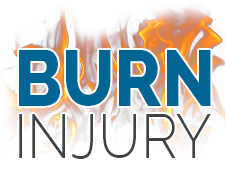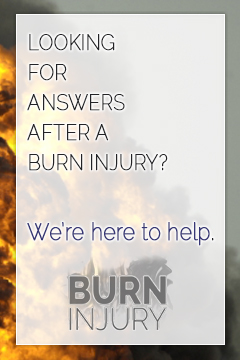Severe Burns
The severity of a burn, along with the type of burn, is important to assess before planning a burn treatment regimen. Burn severity often indicates the recovery time needed and whether or not the burn patient will experience permanent effects, such as scarring or an interference or change in physiological function.
Classifying Severe Burns
Severe burns are typically classified by measuring the total body surface area (TBSA) of the burn injury. This system measures the percentage of burned skin in comparison to the rest of the victim’s body. A burn injury of the same size will result in a higher TBSA for a child than for an adult, due to the child’s smaller body size.
Measuring TBSA
The American Burn Association has set forth guidelines for measuring TBSA and diagnosing severe burns. Burn injuries are typically placed into three major categories. In adults, burns with a TBSA of 10 percent or less are classified as minor burns. In children, minor burns measure five percent TBSA or less. Moderate burns may cover roughly ten-to-twenty percent of adults. In children, moderate burns cover roughly five-to-10 percent. Major, or severe burns, measure more than 20 percent TBSA in adults and more than 10 percent in children.
Causes of Severe Burns
Severe burns may be caused by a number of sources, including, but not limited to:
- Thermal: hot liquids or gases, open flames, and hot surfaces
- Chemical: strong acids or bases, such as sulfuric acid and bleach
- Electrical: high voltage exposure, electric arcs, and lighting
- Radiation: ultraviolet light, microwaves, ionizing radiation such as from x-rays or nuclear fallout
Non-accidental Severe Burns
In some cases, severe burns are intentional. Non-accidental severe burns may occur in cases of abuse against children, elders, or spouses. These severe burns may also result from other personal or business disputes. Child abuse may be indicated by severe burns from immersion into hot water. These scalding burns often present as symmetrical over the buttocks or lower extremity.
Preventing Severe Burns
Severe burns may be prevented by safety measures such as:
- Installing smoke alarms in homes and replacing batteries when needed
- Installing sprinkler systems in homes and offices to automatically extinguish fires
- Keeping candles and other open flame sources away from flammable items
- Testing bath or shower water for several seconds before a child enters
- Removing children from the kitchen while cooking
- Maintaining constant parental supervision while cooking
- Moving hot pans and pots toward the back of the stove to prevent accidental spilling
- Installing splash guards on stoves
- Wearing masks and protective clothing when exposed to dangerous chemicals
Sources:
Chinkes, David L., et al. “The leading causes of death after burn injury in a single pediatric burn center.” Critical Care 13 (2009): R183. Academic OneFile. Web. 21 Dec. 2014.
Gokdemir, Mehmet Tahir, et al. “Clinical Outcome of Patients with Severe Burns Presenting to the Emergency Department.” Journal of Current Surgery. 2.1 (2012): 17-23. Print.
“Scalds: A Burning Issue.” Ameriburn. American Burn Association. Web. 21 Dec 2013. <http://www.ameriburn.org/Preven/2000Prevention/Scald2000PrevetionKit.pdf>.
Wal, Martijn B. A., et al. “Outcome after Burns: An Observational Study on Burn Scar Maturation and Predictors for Severe Scarring.” Wound Repair & Regeneration 20.5 (2012): 676-687. Academic Search Complete. Web. 21 Dec. 2013.
Williams, Catherine. “Assessment and management of paediatric burn injuries.” Nursing Standard 25.25 (2011): 60+. Academic OneFile. Web. 21 Dec. 2013.













